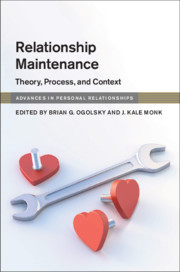Book contents
- Relationship Maintenance
- Advances in Personal Relationships
- Relationship Maintenance
- Copyright page
- Contents
- Tables
- Figures
- Contributors
- Part I Introduction
- Part II Theories of Relationship Maintenance
- Part III Processes of Relationship Maintenance
- 7 Communication and Relationship Maintenance
- 8 Attributions, Forgiveness, and Gratitude as Relationship Maintenance Processes
- 9 Social Networks and Relationship Maintenance
- 10 Dyadic Coping as Relationship Maintenance
- 11 Conflict Management and Problem Solving as Relationship Maintenance
- 12 Sex as Relationship Maintenance
- 13 Accuracy and Bias in Relationship Maintenance
- Part IV The Social Context of Relationship Maintenance
- Part V Conclusion
- Index
- References
13 - Accuracy and Bias in Relationship Maintenance
from Part III - Processes of Relationship Maintenance
Published online by Cambridge University Press: 02 December 2019
- Relationship Maintenance
- Advances in Personal Relationships
- Relationship Maintenance
- Copyright page
- Contents
- Tables
- Figures
- Contributors
- Part I Introduction
- Part II Theories of Relationship Maintenance
- Part III Processes of Relationship Maintenance
- 7 Communication and Relationship Maintenance
- 8 Attributions, Forgiveness, and Gratitude as Relationship Maintenance Processes
- 9 Social Networks and Relationship Maintenance
- 10 Dyadic Coping as Relationship Maintenance
- 11 Conflict Management and Problem Solving as Relationship Maintenance
- 12 Sex as Relationship Maintenance
- 13 Accuracy and Bias in Relationship Maintenance
- Part IV The Social Context of Relationship Maintenance
- Part V Conclusion
- Index
- References
Summary
The belief that a relationship partner values and promotes one’s welfare is central to many theories of interpersonal relationships. In this chapter, we review research on accuracy and bias in these perceptions of benevolence and their implications for relationship maintenance. A key conclusion emerging from this literature is that people’s perceptions of their relationship partners’ benevolence are both accurate and biased. Suggesting the operation of a confirmation bias, people’s chronic and generalized beliefs regarding other people’s benevolence appear to bias perceptions of partners’ benevolence within specific relationships. Suggesting the operation of a motivated wishful thinking bias, people’s desires to maintain close relationships with particular partners also bias perceptions of those partners’ benevolence. Despite these biases, there is also evidence for accuracy in perceptions of benevolence. Each of these processes, in turn, appears to shape people’s willingness to enact relationship maintenance behaviors. Suggested directions for future research are described.
- Type
- Chapter
- Information
- Relationship MaintenanceTheory, Process, and Context, pp. 240 - 262Publisher: Cambridge University PressPrint publication year: 2019

